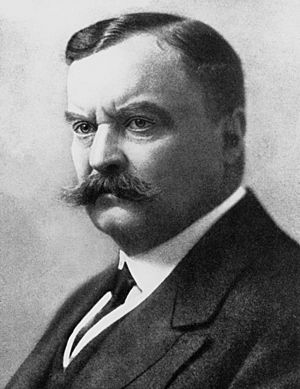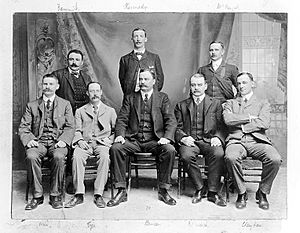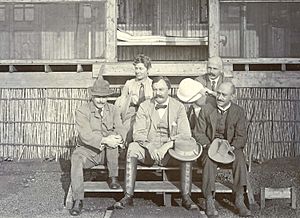David Bruce (microbiologist) facts for kids
Quick facts for kids
Major-General Sir David Bruce
|
|
|---|---|
 |
|
| Born | 29 May 1855 Melbourne, Australia
|
| Died | 27 November 1931 (aged 76) London, England
|
| Citizenship | British |
| Education | University of Edinburgh |
| Known for | trypanosome |
| Awards | Cameron Prize for Therapeutics of the University of Edinburgh (1899) Royal Medal (1904) Leeuwenhoek Medal (1915) Buchanan Medal (1922) Albert Medal (1923) Manson Medal (1923) |
| Scientific career | |
| Fields | Microbiology |
Major-General Sir David Bruce (born May 29, 1855 – died November 27, 1931) was a Scottish doctor and scientist. He made very important discoveries in the field of tropical medicine. This is the study of diseases common in hot, tropical parts of the world.
In 1887, he found a type of bacteria that caused a sickness called Malta fever. This bacteria is now named Brucella after him. In 1894, he discovered a tiny parasite, called Trypanosoma brucei. This parasite caused a disease in animals known as nagana.
Sir David Bruce worked for the Army Medical Services. His wife, Mary Elizabeth Bruce, was also a microbiologist and helped him a lot. They published many scientific papers together. He led a group that studied Malta fever and found its cause. Later, he and his wife investigated nagana in Africa. They discovered the parasite responsible for it.
He also led important groups that studied human sleeping sickness in Uganda. He proved that the tsetse fly carries the germs for both human sleeping sickness and animal nagana. Because of his work, the bacteria Brucella and the disease it causes, brucellosis, are named in his honour. The parasite Trypanosoma brucei is also named after him.
Contents
About David Bruce
His Early Life and School
David Bruce was born in Melbourne, Australia, in 1855. His parents were Scottish and had moved to Australia for the gold rush. He was their only child. When he was five, his family moved back to Scotland.
He went to Stirling High School. In 1869, he started learning a trade in Manchester. But he got very sick with pneumonia. This made him change his plans. He first thought about studying animals (zoology). Then, in 1876, he decided to study medicine at the University of Edinburgh. He finished his studies in 1881.
His Medical Work
After working as a doctor for a short time, David Bruce joined the Army Medical School in 1883. He served in the Army Medical Services until 1919. His first job was in Valletta, Malta, in 1884.
In 1889, Bruce became a professor at the Army Medical School. He worked there for five years. In 1894, he went back to military service. He was sent to South Africa to study a disease affecting cattle and horses called nagana. He and his wife, Mary, moved to Ubombo Hill, where the disease was common.
During the Second Boer War (1899-1900), he and his wife ran a hospital. For his service, he was promoted to Lieutenant-Colonel. In 1899, he won the Cameron Prize of the University of Edinburgh. In 1900, he joined a group studying dysentery in army camps. At the same time, he worked for the Royal Society's Sleeping Sickness Commission.
From 1902 to 1911, Bruce was on the Army Medical Service Advisory Board. In 1914, he became the head of the Royal Army Medical College in London. He held this job until he retired in 1919 as a Major-General. After retiring, he became the head of the Lister Institute. During his career, he wrote many scientific articles. About 30 of them were written with his wife.
His Death
Sir David Bruce died in 1931, just four days after his wife. He passed away during her memorial service. Both were cremated in London. Their ashes are buried together in Valley Cemetery in Stirling, Scotland. They did not have any children.
His Scientific Discoveries
Malta Fever
When Bruce was working in Malta, many British soldiers got sick with what was called Malta fever. This disease was spread by goat milk. In 1886, Bruce led a group to investigate this sickness. Between 1886 and 1887, he studied five patients who died from Malta fever.
Bruce's assistant, Matthew Louis Hughes, named the disease "undulant fever." He named the bacteria Micrococcus melitensis. At first, people didn't know how the infection spread. Hughes thought it came from the soil or air. But in 1905, it was finally proven that goat milk was the source. Themistocles Zammit, another member of the commission, was the one who showed this through experiments.
The name of the bacteria Micrococcus was later changed to Brucella to honour David Bruce. The disease is now called brucellosis.
The Fly Disease and Sleeping Sickness
When Bruce moved to South Africa, he went to Zululand. He was there to study an animal disease that local people called nagana. Europeans called it the fly disease. In 1894, he and his wife found that this disease was common among cattle, donkeys, horses, and dogs.
He found that the tsetse fly (Glossina morsitans), which was common in the area, could carry the parasites. These flies picked up the parasites when they fed on the blood of sick animals. Bruce showed that the tsetse fly was very important in spreading the disease. Later, other scientists, Henry George Plimmer and John Rose Bradford, fully described the new parasite in 1899. They named it Trypanosoma brucei after David Bruce.
The Sleeping Sickness Commission
From 1900, a serious outbreak of sleeping sickness happened in Uganda. By 1901, about 20,000 people had died. Over 250,000 people died during this epidemic, which lasted for two decades. At first, people didn't know that this human disease was related to the animal fly disease. They thought it might be caused by bacteria or worms.
The Royal Society formed a group called the Sleeping Sickness Commission in 1902 to study the epidemic. The first team didn't find the cause.
The second Commission in 1902 was led by Bruce. He was helped by David Nunes Nabarro. By August 1903, Bruce and his team proved that the disease was spread by the tsetse fly, Glossina palpalis. This showed the link between the human disease and the animal fly disease. In the third Commission (1908–1912), Bruce and his team found out all the stages of the parasite's life cycle inside the tsetse fly.
Awards and Honours
David Bruce became a Fellow of the Royal Society (FRS) in 1899. This is a very high honour for scientists. He was also the editor of the Journal of the Royal Army Medical Corps from 1904 to 1908.
He received many awards for his work. These include the Cameron prize in 1901 and the Royal Medal in 1904. He also received the Mary Kingsley Medal in 1905 and the Stewart prize. In 1915, he was given the Leeuwenhoek Medal.
He was made a Companion of the Bath (CB) in 1905. He was knighted in 1908, which means he was given the title "Sir." In 1918, he was made a Knight Commander of the Bath (KCB). He was also the president of the British Science Association from 1924 to 1925.
David Bruce's name is carved on the building of the London School of Hygiene & Tropical Medicine. His name is one of 23 pioneers in public health and tropical medicine chosen for the building in 1926. He was nominated 31 times for the Nobel Prize in Physiology or Medicine for his discoveries about trypanosomiasis. However, he never won the award.
See also
 In Spanish: David Bruce para niños
In Spanish: David Bruce para niños




